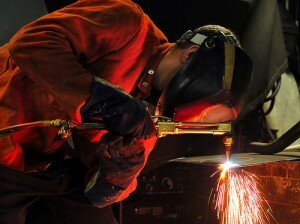 In charting the course of America’s history, it’s easy to see that welders have been there every step of the way.
In charting the course of America’s history, it’s easy to see that welders have been there every step of the way.
President Roosevelt, in a letter to Prime Minister Winston Churchill, bragged about the discovery of new welding techniques that enabled America to build ships with a speed unequaled in the history of shipbuilding.
The first car made with an entirely plastic body was assembled by ultrasonic welding. And welding in space, first attempted in 1969 by Russian cosmonauts, is now essential for projects like the construction of the International Space Station.
This type of work, crucial to the construction of important inventions in America’s history, is pretty indicative of welding as an industry: It’s incredibly important, and often under-recognized. Take NASCAR, for example: roughly 950 hours are spent on welding and fabrication for each race car; they weld and machine hundreds of parts from the chassis and suspension to the drive train. These important hours are rarely recognized by the cheering crowds impressed by what the cars can do.
There’s a lot of hard work that goes into many objects and structures that we take for granted, and welding is a big part of that.
Welders work on everything from building sculptures to constructing nuclear power plants and even working underwater (if you like to dive or enjoy being around the ocean, there are most likely some great welding jobs for you). Allen Garber, chief administrative officer at the Commercial Diving Academy in Jacksonville, Florida, says that welding underwater is a big part of what commercial divers do: “Commercial divers have to find it, clear, it, inspect it, and repair it or build it new– all in diving gear,” Garber says. Much of that repair work involves welding underwater, a challenging and gratifying task.
So, you want to be a welder. You can start of of high school with basic welding skills, and make a decent living, for sure: Maybe $10, $12, or $14 an hour. However, depending on your hard work and what type of welding you enjoy, making two to three times that amount based on experience is absolutely not out of the question. And best of all? There’s a wide variety of jobs open in the field to do some very diverse work: In the manufacturing industry, for example, welders work as sheet-metal workers, structural metal fabricators and fitters, or welders, cutters, solderers, and brazers, to make a great living, travel and work in a variety of places, and explore what their hands can do.”A lot of very intelligent people are coming into the welding community,” says Don Howard, a welding specialist at Concurrent Technologies Corp. “Welding is not just about working on a manufacturing line anymore. Once in the industry, people know they can find a niche.”
Questions? Want to learn more about a career in welding? Send us a or leave a comment below anytime!
—
photo credit: via
 Official Nebraska Government Website
Official Nebraska Government Website
